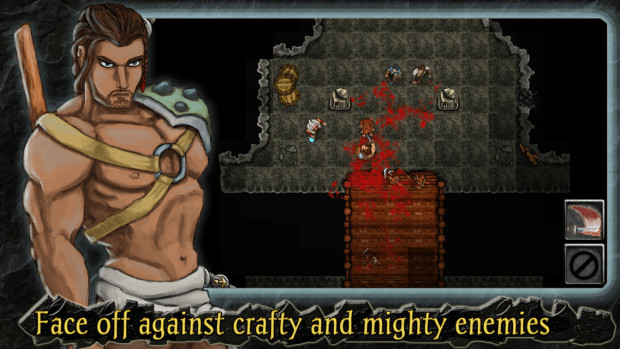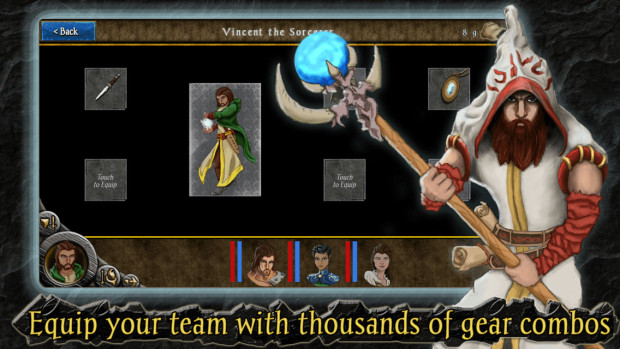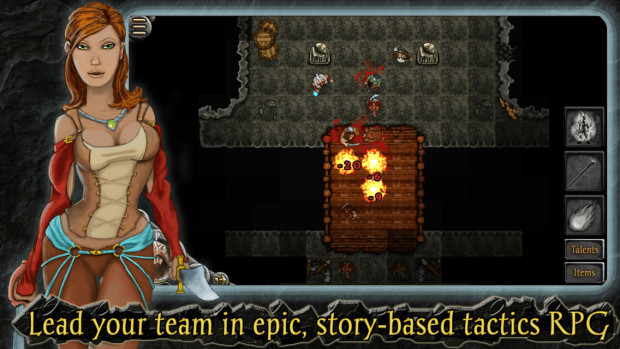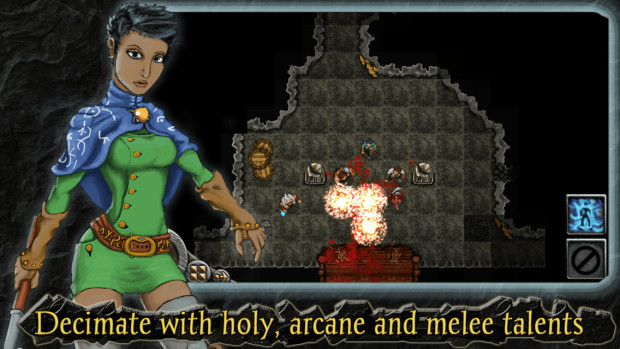In this week’s interview with an indie developer, we hooked up with Andrew Trese, one of two founders for Trese Brothers. Andrew is a programmer, artist, and story-writer for all of the games developed by Trese Brothers and has been working with his brother Cory for almost 4 years now.
Heroes of Steel was a game Andrew dreamed up, so he is the one behind the story, the art, and the characters. Andrew is the younger brother of the duo, with Cory being 2 years older than Andrew. So what’s the story behind two brothers who obviously get along pretty well? Read on to find out!
What got you into game development and how was Trese Brothers formed?
We have both been software developers forever. And we’ve both made games forever. For a while in our adult lives, we were doing those two things separately, but always wanted to work on projects together, even though we live far apart (east coast, west coast). Cory just started messing around one day with Android, and the next thing you know he was building Star Traders. Like we do with all of our software projects, we release-early and release-often, so soon Star Traders was on the market for free. Neither of us expected the kind of response we got, and as soon as we had the game in the hands of 30,000 people we were hooked. Mobile kicked open the door for us and made it possible for us to make games for more people than we had ever imagined, easily and for free.
Normally we would ask where the name of your studio comes from, but given that it was founded by Cory and Andrew Trese, this is rather obvious. Instead a more interesting question: what exact roles do you both play within the studio? Have you divided certain tasks or do you take joint responsibility for everything? Tell us a little about how you’re organised.
We are a very small shop – just two brothers. We are both software engineers by trade and grew up doing game development together. When we started four years ago, we did not have an art team and had no hope of affording one, so I took the plunge and dedicated myself to drawing art for the games.
That means Cory does 90% of the coding. Even though I know what I am doing, I often cause more trouble than good when I start slinging lines of code these days. I am the art director behind the games, so I draw all of our art and do all of our animations. Depending on the game, we have different leads in the other areas. Cory does almost all of the map design for Heroes of Steel, while I do all of the dialogue and story writing. For Star Traders, Cory is primarily in charge, whereas I am the current lead on Cyber Knights. We rotate lead positions occasionally, but we are always talking about and collaborating on the next thing for any of the games, so you’re never really alone on a project.
We’re small, so that demands an even better plan than most businesses I think. We don’t have a margin for error. Therefore, we are constantly grooming the extended roadmap – the year’s plan. It’s an on-going activity, looking at competition, researching changes in the market, drivers, and new things we need to be watching.
It’s a lot to do! We definitely each wear a big pile of hats on our head every day. As a really small shop, you have to be ready to jump in and do it all!
When you guys aren’t developing indie games, what do you get up to?
I’m currently training for a marathon, which pretty much eats up all of my leisure time. I live in Boston on the east coast, so during the winter I’ve also been up into ski country getting in days on the slopes. If you are going to live somewhere that has a winter, I think it’s important to have a winter hobby that embraces it. Then when it’s almost over, I wish it wasn’t because I want one more day of skiing!
Cory lives on the west coast in California and spends a lot of time off-roading on logging roads and in national parks. He’s also a great photographer.
Oh, and hanging out with our lovely wives who bravely supported us through this roller coaster called small-shop indie development!
Could you tell us a little about Heroes of Steel? What inspired you to make this game?
I have always run a pen and paper game, almost always fantasy. The campaigns and the groups of friends change, but it’s something I am always doing on the side. This causes me to dream a lot about stories that I’d love to see in a campaign. Often, the whole idea for a campaign starts from a single scene I dream up and then elaborate on and build on. Heroes of Steel started as an idea for a pen and paper RPG campaign and blossomed into the grim storyline we are telling today. I like darker storylines with hard struggles, and always like to say that you can’t celebrate the best of times unless you’ve know the depths of the worst of times.
In Heroes of Steel, the world has fallen. Four of the Gods turn on the creator, the All-Father and destroyed him. The whole world came apart shortly after – earthquakes, volcanoes, a great glacier crept in from the north, and the seas drained out. The monstrous races, led by the Four dark Gods, crushed the human kingdoms under their boots and all was lost. Only a few survivors escaped into the depths of the earth, into a mysterious labyrinth known as the Underdeep. There, in a post-apocalyptic world, they have scratched out a living, re-established basic farming, trade, and politics and tried to see a future. Seventy years later, things are not going well … the world needs heroes. That’s where your unlikely group of four come in.
What is your main vision of the game? Why will gamers fall in love with Heroes of Steel over any other game in its genre?
I hope people will fall in love with Heroes of Steel for two reasons: compelling story and engaging tactics.
The story of Heroes starts off on a great note – four unlikely individuals tossed into jail. They get to know each other passingly and decide to make a desperate escape attempt. Most of them have secrets, pasts they would rather not discuss, something following them. I don’t want to spoil it honestly – but you will get swept up in and take part in a powerful story of four friends, facing both mystical and all too human problems. The story is interwoven; you’ll work with many of the same characters, friends, and enemies throughout, struggling against impossible situations, suffer loss and hardship, and your share of victories too. Not sure I want to try to describe it more – give it a try, I hope you like it.
The tactics part of Heroes of Steel is unique and challenging. It’s a great turn-based tactics RPG. Where it really shines is that it is team tactics. You have four unique character slots (Warrior, Mysitc, Healer, Sneak), which you can fill with different characters, such as the fire-wielding Wizard or the lightning-blasting Sorcerer. The big challenge in the tactics system is to build a team strategy that is dynamic and capable of winning. No one character can do it alone; the enemy would overwhelm them. You can’t simply rely on your Warrior, and you’ll get a poor result if you focus every character on their most deadly attack talent. Each character has 10 different unique talents, and you need to pick your strategy of which Talents to and most importantly, how to combine them, to overcome the enemy.
Oh, and we provide real difficulty scales. Nightmare is hard. So, if you have mastered one level, going up to the next one is going to test your skill in a significant fashion!
How did you go about designing and producing the game? Can you tell our readers a little more about your process and working methods?
Cory and I collaborate really well, maybe because we are brothers, maybe cause we both know how to compromise and really trust each other. How do we design games?
First, we agree on a game we want to build. This can take a long time. We have so many ideas, but it’s critical to find something that we are both excited about, that and given time. We can only make so many games, so it’s important to bring a lot of energy to the table and to really make an awesome game every time. So, picking the right project is key.
Then we go through a design phase where we are brainstorming game concepts and mechanics. We use Google Docs for everything (and you should too!), so this results in a massive splatter of drawings, spreadsheets, and documents with all sorts of various data, flow charts, UI design, and math to back up the systems. We go to town in this phase, and aren’t writing more than a little prototype code. As an artist, I start combing my favourite artistic sites, looking for inspiration for the project during this time, trying to hone in on a visual style I want to use for the game.
Once we have a lot of the design roughed out (it’s far from done) we code a playable prototype. It has to be playable and fun, even if it’s an ugly baby.
From there, it just gets down to the business of game development. We have a lot to do every day, so we organize our work into sprints – short iterations of “plan the work, work the plan.” So, once a week we sit down and plan all the things we need to get done this week, and then we get to work. Rinse, repeat. If you are disciplined, have a good over-all plan, and work hard, in a few months you have a game ready for alpha!
How are you guys finding the indie developer life so far? The biggest discussion we always have with indie developers is how hard it can be from a financial point of view. How do you manage?
We are coming up on our year anniversary of going full time into game development. The first three years we did game dev, the hard part was not financial, it was finding the time. We were both full time software architects at demanding jobs. For three years we were crazy warriors of the late nights and weekends. Actually, that hasn’t changed much!
We were lucky to have had three years of good finances, where we worked elsewhere and were able to build a war chest for the business. We stocked up funds, and the KickStarter was a big boost to that which got us off to a strong start. We are looking forward to new games and a second KickStarter to help us keep moving forward!
The most exciting change for us is now reaching lots of platforms – Android, iOS, PC with every new game. Technologically, we used to be limited to Android only, which really put the squeeze on.
Heroes of Steel managed a successful KickStarter campaign. Can you describe what this process was like for you? Was it a stressful period?
Yes, it was stressful. But in more of a good or excited kind of way. We have an amazing community, and they really came out in strength to support us. We posted the KickStarter and then I forced myself to go to bed. When I got up 8 hours later, we had already raised 25% of the goal. We have the best fans in the world, so that set the whole project off to the right kind of start, and then it was stressful in a “how far can we go?” way! We made it to just the right spot, achieving our stretch goal the Epic Platform Pack which demanded that we make Heroes of Steel for Android, OUYA, iOS and we decided to toss PC in on top.
The stressful part was working day and night to find and contact all the people we had interacted with over three years of gaming, community engagement, and customer support. And writing an update a day for 30 days, that was fun too!
After investigating your studio following your e-mail, I found out you’re the guys behind a few mobile titles I actually have installed on my phone. That’s quite something as I rarely play or install anything on my phone – both Star Traders and Templar Assault are among 10 things I ever installed on my phone. What made you guys move from mobile games to the PC? (And we’re glad you did!)
Haha, that is awesome! That makes this interview even more fun to do. We love working with fans of our games. Really, the driving factor to come over to PC was the Heroes of Steel KickStarter. Once we committed to make Heroes of Steel cross-platform (we only promised Android & iOS) we knew we had a responsibility to go further and to push ourselves to get to a wider set of platforms. PC was the next step.
Also, we have always worked hard to make big, challenging games. We try to make games that are more expansive and deeper than games you usually find on mobile. So, this translates really well to PC. We make PC-sized games already, we just cram them onto a phone! Now, we’ve unleashed them on your big screen.
Have you got any other projects in the pipeline you can tell us about – either in production or at the ideas stage?
Absolutely! We are really excited to be preparing for another KickStarter. We are coming back to our original gaming world and are going to make Star Traders 2. It’s a game concept that has fascinated our community for years, and they’ve asked over and over that we make it. And, finally it’s time. We are looking forward to launching the KickStarter sometime around April or May!
If time and money was no object, what kind of game would you see yourselves producing?
I have always had a sweet spot in my heart for pen and paper games. A lot of our game development experience is in making pen and paper games, and there is something you can’t beat about sitting around a table with friends and gaming that way. If money was no object, I’d work on finishing one of the pen and paper games we’ve built over the years.
I know Cory has always wanted to build a 4X game – it’s a big dream of his!
Thank you very much for your time. We’d like to wish you the best of luck and hope we’ll see your studio release some really great games in the near future! Keep us informed.
Thanks! It is always a lot of fun to try to explain who we are and how we see gaming as a dev group. We’re a small shop, so for us, it’s all about interaction and engagement. We hope your readers will try the games and reach out to us!
[youtube link=”http://www.youtube.com/watch?v=EUabKjL9iTQ” width=”590″ height=”315″]
For more information on Trese Brothers and Heroes of Steel
Heroes of Steel Home Page – http://www.tresebrothers.com/heroes-of-steel/
You can also find Heroes of Steel on Steam Greenlight and Desura.
Alternative, if you wish to try the Mobile version: Google Play or Apple App Store.
And here are some more Screenshots:
[minigallery id=”6021″ prettyphoto=”true”]



